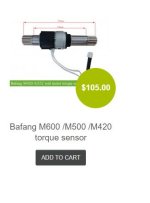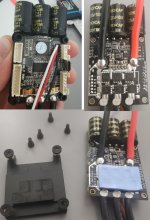casainho
10 GW
- Joined
- Feb 14, 2011
- Messages
- 6,047
Finally I got the torque sensor readings working. Turns out the issue was because I forgot to put the 75 ohms resistor on the CANBUS. But also it was needed a change to the Adafruit library, because this board uses a 8MHz crystal and Adafruit boards uses 16MHz.
Here is the torque sensor data:

And here is the current state of the board. Yes, the CAN board is big:

Before start doing the EBike application, here is what is working and what is missing:
- [x] Throotle read
- [x] Torque sensor read
- [x] Brake sensor read
- [x] Wheel speed sensor read
- [x] VESC motor control
- [ ] Display
So the display communication will be my next step. The display I will be using is the Easy DIY display.
If anyone prefers a bigger and color display, even easier to build, this boards with ESP32 + display, seems perfect. It only needs 4 wires to be soldered, from the EBike board: 5V, GND, UART TX and RT. It also needs a 3D printed shell.
There is no EBike display application for that board, but I assume it can run Python and then an application can quickly be developed. Being Python, that means the same application will work on other similar boards - with bigger or smaller displays.

Here is the torque sensor data:

And here is the current state of the board. Yes, the CAN board is big:

Before start doing the EBike application, here is what is working and what is missing:
- [x] Throotle read
- [x] Torque sensor read
- [x] Brake sensor read
- [x] Wheel speed sensor read
- [x] VESC motor control
- [ ] Display
So the display communication will be my next step. The display I will be using is the Easy DIY display.
If anyone prefers a bigger and color display, even easier to build, this boards with ESP32 + display, seems perfect. It only needs 4 wires to be soldered, from the EBike board: 5V, GND, UART TX and RT. It also needs a 3D printed shell.
There is no EBike display application for that board, but I assume it can run Python and then an application can quickly be developed. Being Python, that means the same application will work on other similar boards - with bigger or smaller displays.





































